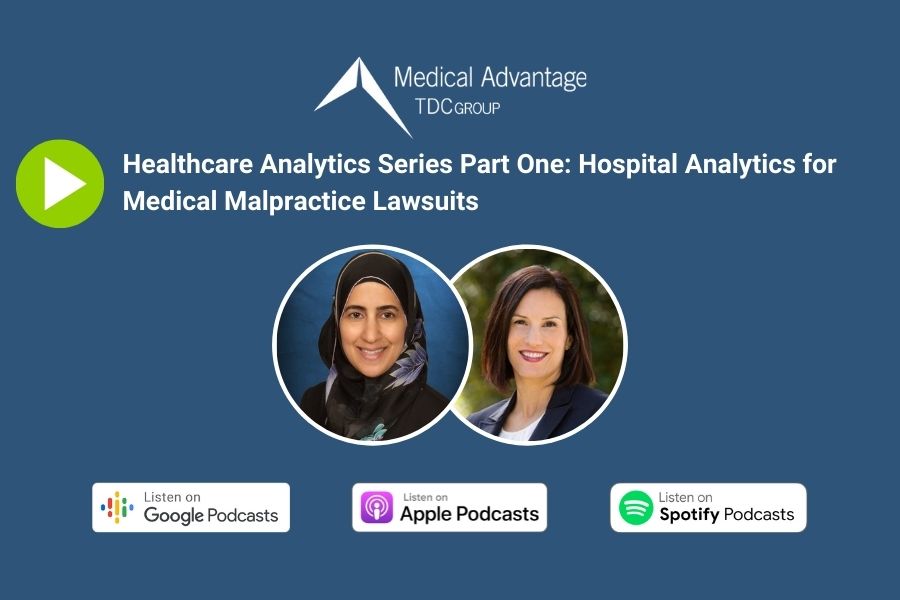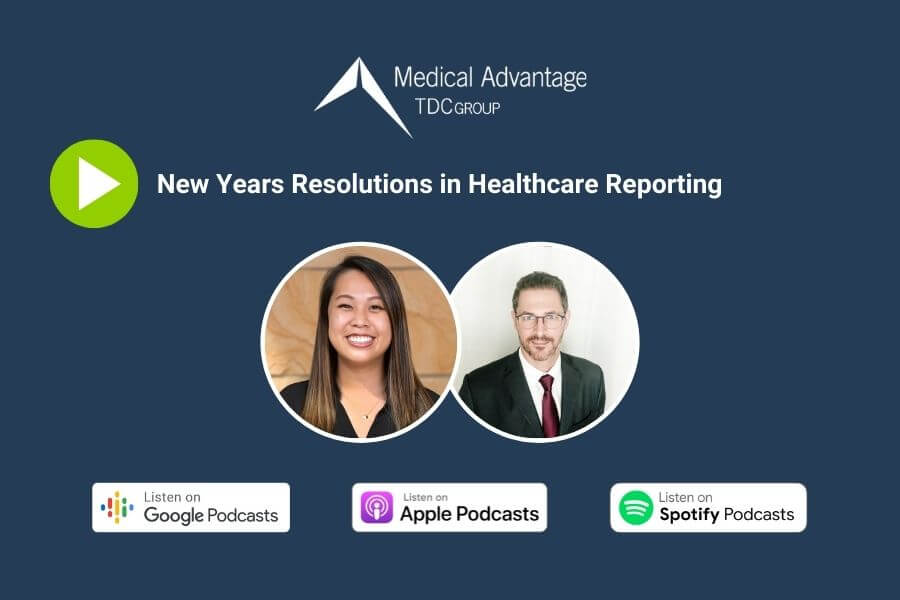In the digital era, the use of data and analytics to assess and improve performance is essential – and perhaps nowhere more so than in healthcare. In this first episode of a podcast sub-series on healthcare analytics, experts will discuss how analytics can help predict and prevent adverse health events, both improving patient outcomes and reducing the chance of medical malpractice lawsuits in the process.
In this episode, we sit down with Darline El Reda, Medical Advantage’s Vice President of Population Health and Strategy and Solutions, as well as Veronique Grenon, data specialist with Healthcare Risk Advisors in New York State. Discussed will be a recent scenario with a hospital in New York which was struggling – and how analytics revealed the root of the problem to be more complex than initially thought.
This is the first part in a sub-series on healthcare analytics. Stay tuned to hear more episodes on analytics as they relate to population health, physician performance, value-based care physician practices, hospitals, and more.
This is the latest episode in the Medical Advantage Podcast, where each we take time each episode to discuss the ideas and technologies changing healthcare, and the best practices your organization can take to stay productive and profitable. Subscribe wherever you get your podcasts to ensure you never miss an episode.
Subscribe to the Medical Advantage Podcast
Contact Our Team Today
Full Episode Transcript
Medical Advantage Podcast: Welcome to the Medical Advantage Podcast, where you can hear healthcare professionals, expert consultants, and industry thought leaders discuss the exciting new ideas and technologies that are changing the business of healthcare. Tune in to each episode as we hear from some of the most innovative minds in medicine about the future of healthcare and how your organization can stay profitable, efficient, and on top of industry best practices.
Dyana Gebauer: Welcome everyone. I’m Dyana Gebauer, for those of you familiar with the Medical Advantage Podcast, welcome back. This is the start of a new series. We’re gonna be focused on healthcare data analytics. And given the priority and importance of healthcare data for today’s hospitals and health systems, as well as physicians and practices, we’re gonna start with a series of episodes where we will explore this topic from a variety of angles.
For example, we’ll take a look at population health, physician performance, value-based care, and specifically today, we’ll be looking at data from a hospital perspective and what medical malpractice carriers can do differently in today’s environment.
First, let me introduce our panelists. With us today, we have Dr. Darlene El Reda. Darlene, would you mind sharing a bit about your background and your role at Medical Advantage?
Darline El Reda: Sure. Thank you, Dyana. I am a public health epidemiologist by training, have been working in the field for over 20 years now, both in public and private sector, and have quite a bit of experience in the use of administrative payer data to design, you know, metrics, methods and programs in the space of assessing provider performance as payers continue to transition between fee for service initiatives and value-based care initiatives.
I am currently the VP of Population Health Analytics and Strategy at Medical Advantage.
Dyana Gebauer: Great. Thank you Darlene. We’re excited to have you today.
And also as our special guest, we have Veronique Grenon who is with one of our sister companies, Healthcare Risk Advisors out of New York. Veronique, would you mind sharing the same about your background?
Veronique Grenon: Absolutely. Thank you, Dyana. I am a property and casualty actuary and I’ve worked in the insurance industry for over 20 years.
I’ve had the chance to work in multiple countries and occupy various positions from pricing to underwriting, to reinsurance purchasing. I also worked at Stanford Hospital and Clinics in the risk management department. That gave me, I would say, a real hands-on experience with hospital risk management.
And finally, I held an insurance tech advisory role. So the combination of those roles is giving me a really interesting perspective and I’m really excited about the opportunities that we have to reduce liability exposures.
Dyana Gebauer: Great. Thanks so much for being with us today, Veronique. This is gonna be an exciting conversation with the both of you. So before we jump in, let me try and set the context a little bit for today’s conversation from the perspective of hospital medical malpractice claims and the opportunity to leverage data to understand it and ultimately prevent adverse events.
We’ve worked with clients in this space before and I understand that we recently have an example that we’ve done that can highlight some of the work in data that hospitals should be considering as they go forward. So would you mind jumping in and explaining some of that activity that we’ve worked on recently?
Veronique Grenon: Yes. One of our clients asks us to help them understand why they have a larger frequency of medical malpractice losses when compared to some of their peers, and that was for a specific department and we’re lucky to have clients that do come up to us with these questions. I do think data should guide the risk reduction strategies. Their difficulty, though, is that medical malpractice can be very challenging.
And I think it’s challenging for the three main reasons. I would say the first one in the small volume of data hospitals might have hundreds, maybe a few thousand claims, and it makes it difficult to perform, I would say, advanced analytics on those small dataset.
There’s also a problem with the number of variables that we have for a single claim, and it makes extracting the important variables very difficult. So I would say that’s one of the challenges, the second one is that we also don’t have data from control. So we can analyze very deeply the claims, but we don’t have necessarily adverse events or outcomes that are not leading to claims or not leading to lawsuits, and that makes it difficult to predict those claims and lawsuits.
I would say there’s a third challenge, which is that it’s really hard to get good exposure data. In number of beds, you know, the typical, traditional number of beds, number of visits, number of surgeries. It’s just not enough to really understand the true underlying exposures and those trends. So, for example, what types of procedures, what types of injuries, what types of diagnosis, and that is where we’re very lucky to have Medical Advantage that we can work with Darlene and her team to help us really go and understand those data sets and those underlying exposures.
It’s a whole different type of data and it’s great to have different expertise to help us work through that.
Dyana Gebauer: Great. Thank you Veronique. So it sounds like there are capabilities that you think hospitals need to have or need to look for in their carrier in terms of analytics perhaps with volume or complexity.
And it seems like we’ve done a little bit more in terms of that assessment than hospitals or clients are used to. Darlene, can you speak a little bit about your role in that client interaction?
Darline El Reda: Sure. So as Veronique mentioned, historically the use of data in understanding risk profiles for medical malpractice insurance has been limited to the data that comes after a medical malpractice event or a claim has been been filed. On the Medical Advantage side, what we have quite a bit of experience analyzing are data that exists on an ongoing basis as healthcare delivery services are rendered for patients as facilities like hospitals and ASCs are rendering procedures.
So, you know, things that are captured on the electronic health record, things that are captured on claim forms. You know, we’re lucky on the Medical Advantage side that we support clients, medical, you know, physician practices institutions. Overall population health management and understanding the underlying disease, demographic of their population, the services that they receive, and we’re doing that with a focus on making sure that they’re successful in their value-based care programs.
And it turns out that in order to do that, you have to use that, you know what used to be simply transactional payer data, to then actually build profiles of your patients. Which of course if you turn, flip the quarter on the other side is then potentially data that can be used to profile the performance of your practitioners, your providers.
So here in this space leveraging you know, our experience in pulling out basically the procedures, the diagnoses, the underlying risk from claims data and EHR data we then, are able to support Vero and her work to understand what is going on on a day-by-day basis inside hospitals well ahead of malpractice claim showing up for that client.
Veronique Grenon: Yeah. And you know, Darlene, if I can jump in here and just give you an example of this and, and if one of our hypothesis is that, communication between the patient and or the family members and the care team is, is an important determinant for a patient that has suffered an adverse event, let’s call it a medium hard temporary harm.
And it’s a determinant for potentially a patient filing a lawsuit. So what dataset will give us the ability to answer that question? Well, it’s not going to be immediate, immediately found in a medical malpractice last run. To answer that question, right? We need to have a variable or a proxy for that variable.
And we need to also have that control group. We need to know if that variable was also present in a group of of people that did not bring up a lawsuit. So this is where, you know, Darlene working with you, it’s extremely exciting because you’re able to help us understand what are those data points that can really advance the building of our model to understand the probability of lawsuits.
Darline El Reda: Yeah. Thank you. And I think there, you know, we’re really excited about the extent to which data already collected in everyday practice in the EHR can help there.
So, for example, we know the EHR houses, whether, you know, a certain clinical test was run and then it houses the result of the test. And then you’re able to configure it to give you an alert about reaching out to a patient for an abnormal result, you know, and close that alert with the disposition, you know, patient contacted, or patient, you know, unable to contact. Those are potentially, I think, what Vero is calling potential proxies for that connection to, to patients, right? The, how much in terms of frequency, how much interaction is there between the provider of the healthcare services and the patient.
Veronique Grenon: Yeah, exactly. And was it a patient that had been followed up with a specific physician for a long time or was it a first visit? Right. So, and so there’s so much that we can uncover by looking at this kind of data, right?
Dyana Gebauer: So it sounds like there’s really an opportunity to kind of shift from the traditional way of doing things and thinking about data for hospitals and health systems and to really talk through the availability of current data and correlating data from multiple sources.
And Darlene, I’ve heard you reference something called the three Vs. Can you speak to that a little bit more?
Darline El Reda: Oh, sure. So I think that we, I talk about the three Vs when we talk about, you know, quote, unquote big data. Meaning you know, everyone recognizes that there’s so much data being produced on a hourly basis on a daily basis, right.
The first V is the volume. The volume of data that we currently have in this day and age at our fingertips is unprecedented. And the velocity at which the data comes is also something we have never seen before. And the volume, velocity, and variety of data.
And you can look at it two ways. You could look at it as presenting a set of challenges in terms of how do we ever keep up, you know, with the velocity, with the volume, and with the variety, but, the way that we’d like to look at it is this is really exciting times. There’s more data available to us now than has ever been available to us.
This is the time to actually use the opportunity to try and get as much out of this volume and variety of data as we possibly can to continue to peel back, you know, the layers of the onion around understanding medical malpractice risk and more importantly, the determinants of that risk, right? The predictors of that risk so that we can identify them and put them under surveillance and continue to track them over time.
These are practices in big data that frankly are tried and true in the public health space. We’ve been doing that in that space quite a bit and bringing forward that skill level to work with big data and tackle those three big Vs really is the future of where we want to go in medical malpractice risk management.
Veronique Grenon: And if I can add to that, I think the way to get there is also to build the right capabilities. The capabilities in terms of skills, expertise, and technology. And we shouldn’t be scared about bringing different skill sets together. At HRA, our team is made up of statisticians, data scientists, data engineer and architect.
And now we have you as epidemiologist expert. We also need to build those technology capabilities. Excel is a great tool but we need to have more if we’re gonna house large volume of data, if we’re gonna be ready at some point to take on IOT data potentially. So that’s something that we’ve invested a lot this year at HRA and we’re really excited about having that modern architecture so that we can really jump into that big data.
Darline El Reda: Yeah, absolutely. I mean, I think, you know, generally that’s talked about in this space around people, process, technology. And, you know, alone epidemiologists are not medical malpractice and actuarily trained and experts in that domain. And the same for, you know, actuaries in terms of expertise in, you know, population level analytics and understanding both, you know, clinical and non-clinical processes, but the real value that we bring to clients is the collaboration across those sets.
And I agree. You know again, taking like what we’ve learned on the public health side. An Excel spreadsheet is fine when you’re looking for, you know counting adverse events like an adverse, something that goes wrong in a a set of birth in a given year at a small village where there may be only 10 or 15 or 20 live births in a year.
But then you fast forward to well now I have birth certificates for millions and millions of live births that collect data about the mother during pregnancy as well as some key clinical outcomes at the time of live birth. And now you’ve basically, you’re required to kind of step up or move to a higher level of technologies and tools that can actually help you manipulate and manage that type of volume of data as Vero suggested, the warehousing, the data processing, and the people that basically know how to get insights from that variety of data.
Dyana Gebauer: Interesting. So as you both collaborated and brought in your unique expertise in combining data, what results did you see in particular with a client we mentioned earlier in our podcast?
Veronique Grenon: Yeah, I can start and Darlene feel free to add. I would say this project has taken two paths, I would say the first one is we’re working together towards a solution for more efficiently structuring and entering the data for them going forward. So that’s going to lead to efficiency, operational efficiencies.
We’ve also created dashboards to monitor some specific exposures that we felt were more likely to result in medical malpractice, or that were more likely to have liability exposures. And we’re continuing to work with them. This is work in progress, I would say there’s another challenge with medical malpractice data, which I haven’t mentioned before, but it’s the length of time that it takes to actually see results.
If we’re gonna have an intervention, or we put a change in place it can take easily 3, 4, 5 years to start seeing results. If we do, the volume of data is so small, so again, working with Darlene and and utilizing other data sets to help us measure earlier some of the impact of the changes, I think is a great advantage.
Darline El Reda: Yeah, I agree. I mean, that’s the hard outcome, right? Is that medical malpractice experience. And it does take time. But there are more immediate process metrics that are on the path of that are, you know, very important also in this space, you know increased patient satisfaction, potentially decreased burden of our practitioners that are both practicing medicine and, you know, helping us capture data.
So there are indicators along the way that that are meaningful in and of them themselves in addition to giving us early indication for are we at least headed in the right direction. Because we know they’re in the causal pathway for medical malpractice further down the line.
Dyana Gebauer: Great. So it sounds like there’s opportunity in today’s market for hospitals to mature their analytics and really request more data or more insights from their medical malpractice carrier in monitoring events or utilization and how that all correlates. Any other thoughts on lessons learned or things for our listeners to consider in today’s market?
Veronique Grenon: I would say on my side, for us actuaries working in this field and in other fields, where there’s not a large volume of data I think we have to be very curious. We need to constantly seek other dataset, new dataset, and not be limited, but what we’re used to working with, but really go and explore what’s out there and I think it’s going to lead to great results.
Darline El Reda: I second that. I think via, you know, analytic curiosity and with a sense of a relentless incrementalism approach, right. But what can this data tell me and what can this data tell me and what can that? And a pursuit for continuing to find these proxies that can help manage risk earlier for our clients is I think the future of medical malpractice risk management.
Veronique Grenon: And do it together, not alone. We just bring together all of those different skillsets and experiences. And I think it’s going to really speed up the process and the results
Darline El Reda: Absolutely. So I wanna play off that point a little bit or extend it out. When we say do it alone, I don’t think we’re just talking, you know, about Vero and her space of actuary analytics and me and my space of health services types of population analytics.
But you know, historically when you’re talking to physician groups or hospitals or this such, and you’re talking about medical malpractice, you’re sitting around the table or across from you are sitting folks in, you know, risk management or the insurance folks or the, you know, chief financial officers.
You know, when you’re talking about understanding proxies and understanding the population of patients that you’re serving, kind of like you’re opening up the dashboards and the monitoring metrics to a larger audience. Well, it’s fine. The CFO should stay at the table and the risk management folks and the lawyers and the such, but you’re also inviting into the room folks that have made a career on monitoring quality outcomes and clinical outcomes.
And I think that that’s what that’s going to look like, is the collaboration of the data people on both sides of this. But also those that are deep in provision of services on a day-to-day basis, who perhaps have not thought about how, what they do on a day-to-day, how they collect data, the level of specificity that they use to collect data, how all of that taken together can really potentially change the risk profile of their of their setting.
Dyana Gebauer: Wonderful. Well, I I thank you both very much for your time today. I always find conversations with each of you very insightful. I look forward to us speaking together again in the future on these topics. When we come back again, we’ll dig deeper and revisit some of those earlier examples I gave of topics on population health and value-based care, and additional ways to think about analytics and insights as we move forward in today’s landscape.
So I thank you both for your time today and to our listeners, we will be back again. Thank you.
Medical Advantage Podcast: Thanks for joining us this week on the Medical Advantage Podcast where we discuss the ideas and technologies changing healthcare and what they mean to your organization. For more information, visit us at medicaladvantage.com and make sure to subscribe to the podcast on iTunes, Spotify, or wherever you get your podcast, so you never miss a show.








